May 17th, 2023 by Carolyn Foley
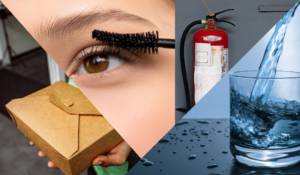
Per- and polyfluoroalkyl substances (PFAS) are a suite of hundreds-to-thousands of manufactured “forever chemicals” that are persistent in nature and toxic to many organisms. Additional chemical precursors, metabolites, or degradates to PFAS and related substances exist in nature and have potential to be toxic to many organisms. While much remains to be learned about the fate and transport of PFAS and related compounds in the environment, people and communities are currently being impacted by the ubiquitous nature of PFAS and related compounds—for example, in drinking water, food, packaging, personal care products, and building materials.
With support from the National Sea Grant Office, the Illinois-Indiana Sea Grant College Program (IISG) has $400,000 to invest in promising research projects relevant to social and economic impacts of PFAS exposure, mitigation, and remediation in the Great Lakes and Lake Champlain regions. For purposes of this competition, “PFAS” refers to any component of the suite of per- and polyfluoralkyl substances and related compounds, including precursors. Work is to be conducted between October 1, 2023 and March 31, 2025. Work can be conducted anywhere in the Great Lakes and Lake Champlain regions so long as it supports the priorities identified in this document. Priorities were identified via a series of scoping activities (3 workshops, 1 survey) in early 2023.
A full report of the scoping effort, which includes additional details on key demographic groups and research needs for the regions, can be found at the project webpage. The full request for proposals including submission guidance is available, but a synopsis is also provided below.
Projects should propose to answer a clear research question or set of related questions, should focus on one or more groups that live, work, and/or recreate in the Great Lakes and Lake Champlain regions, and should demonstrate fit with one or more of the following research priorities. The priorities are not listed in any particular order.
Understanding exposure to PFAS
- Improved understanding of how different groups or communities may be differentially exposed to PFAS, e.g., higher consumption of fish on a regular basis; use of well or other waterways that are not regularly monitored or not currently monitored
- How exposure and consumption to PFAS translates within the context of traditional knowledge
Communicating risks and actions for PFAS
- How to best communicate uncertainty surrounding the scientific knowledge of PFAS and its effects, while also ensuring members of the public, or specific communities (e.g., those at higher risk of PFAS exposure, those more susceptible to effects of PFAS) take appropriate action to keep themselves safe
- How to effectively communicate taking action(s) that are most successful at reducing or preventing PFAS exposure
Economic impacts of PFAS
- What are the economic impacts of PFAS contamination on communities, considering matrices such as drinking water, fish consumption, solid waste application
- Cost-benefit analyses of the most effective and efficient treatment methodologies for PFAS
Policies and regulations for PFAS
- How to implement effective policies and regulations around PFAS including at local, regional, and international levels
- Examination of the potential impacts of total vs. partial bans of PFAS
Prospective PIs must submit a letter of intent at least 4 weeks before the full proposal submission date. Letters of intent should be emailed to iisg@purdue.edu by July 3, 2023.
Applicants who provided a letter of intent on time should submit all proposal materials via https://esg.iiseagrant.org/ by 11:59 p.m. Central time on July 31, 2023. Applications should be submitted to the “Regional PFAS Research Competition.”
Questions about this opportunity should be directed to BOTH Amanpreet Kohli (kohli19@purdue.edu) and Carolyn Foley (cfoley@purdue.edu).
Illinois-Indiana Sea Grant is a partnership between NOAA, University of Illinois Extension, and Purdue University Forestry and Natural Resources, bringing science together with communities for solutions that work. Sea Grant is a network of 34 science, education and outreach programs located in every coastal and Great Lakes state, Lake Champlain, Puerto Rico and Guam.
Contact: Carolyn Foley, Sarah Zack
March 16th, 2023 by Carolyn Foley
Chances are good that you’ve heard the term “PFAS” in the news, including that they are “forever chemicals” found at airports and military sites but also in everyday household items like pots and pans, makeup and drinking water. While scientists know that PFAS are per- and polyfluoroalkyl substances, have very strong bonds that allow them to persist in nature, and exist in hundreds of different forms, there is still much to learn.
In 2022, Illinois-Indiana Sea Grant (IISG) was awarded a grant from the National Sea Grant Office to help explore this issue. Specifically, IISG plans to support a Great Lakes and Lake Champlain regional research competition focused on social and economic issues related to PFAS risk, exposure and remediation. But first, the project team sought to review the status of PFAS research knowledge and needs in the Great Lakes and Lake Champlain region. The team hosted three scoping sessions in March 2023, focused on PFAS risk and exposure, PFAS mitigation and remediation, and PFAS governance and prevention.
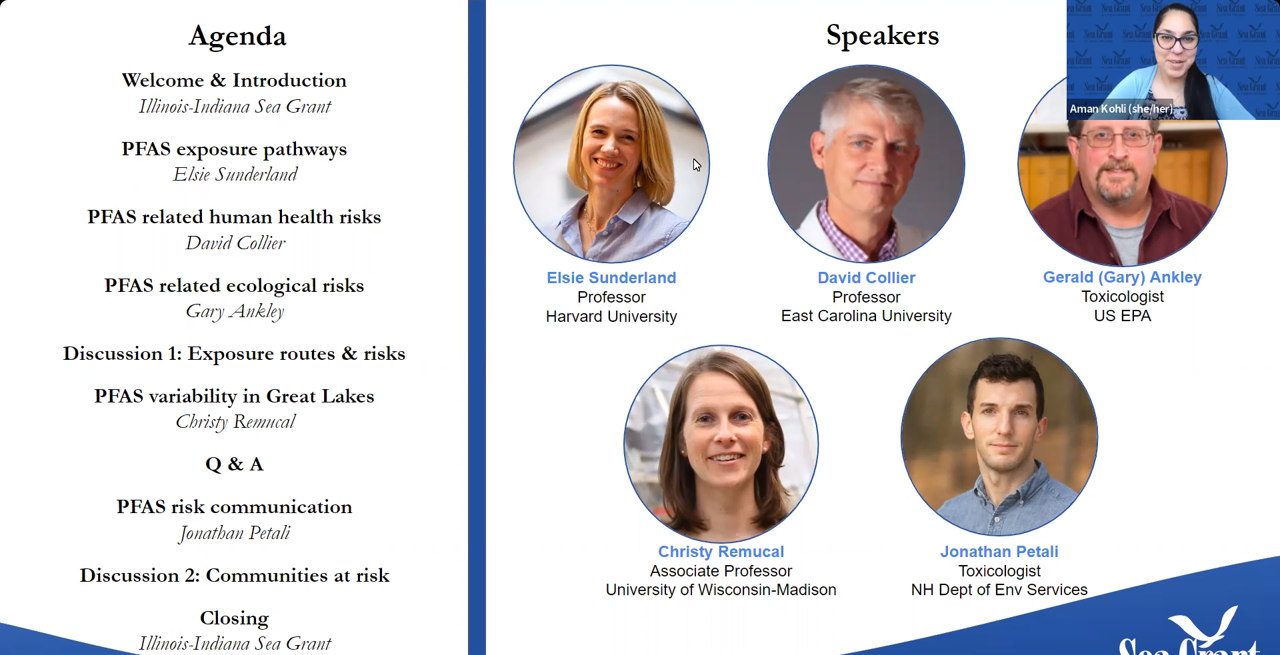
Project Coordinator Aman Kohli reviews the agenda and introduces the speakers during the first session.
More than 60 participants from federal, state, provincial, tribal, consulting and academic institutions joined over the course of the three sessions. Presentations and discussions centered around three main questions:
- Which communities are at risk, and what are their sources and routes of exposure?
- What are the socioeconomic barriers to the adoption and implementation of some of the current/proposed solutions, and what are their alternatives?
- What information is needed to ensure all who live, work and recreate in the Great Lakes region are treated in a just and equitable way with respect to governance and prevention of PFAS contamination and exposure?
Participants shared many thoughts and ideas beyond those that will be incorporated into a Great Lakes and Lake Champlain regional request for research proposals (RFP) to be issued in May 2023. The project team—which includes IISG Director Tomas Höök, IISG Research Coordinator Carolyn Foley, IISG Pollution Prevention Specialist Sarah Zack and Project Coordinator Aman Kohli—plans to issue a publicly available workshop report in spring 2023 that includes ideas shared, research and information needs, and other concepts for further exploring PFAS in the Great Lakes and Lake Champlain region.
If you would like to receive emails related to funding competitions, including when they are open, please subscribe to our research mailing list. *Note that Purdue Mailman services are secure despite some warnings that may pop up.
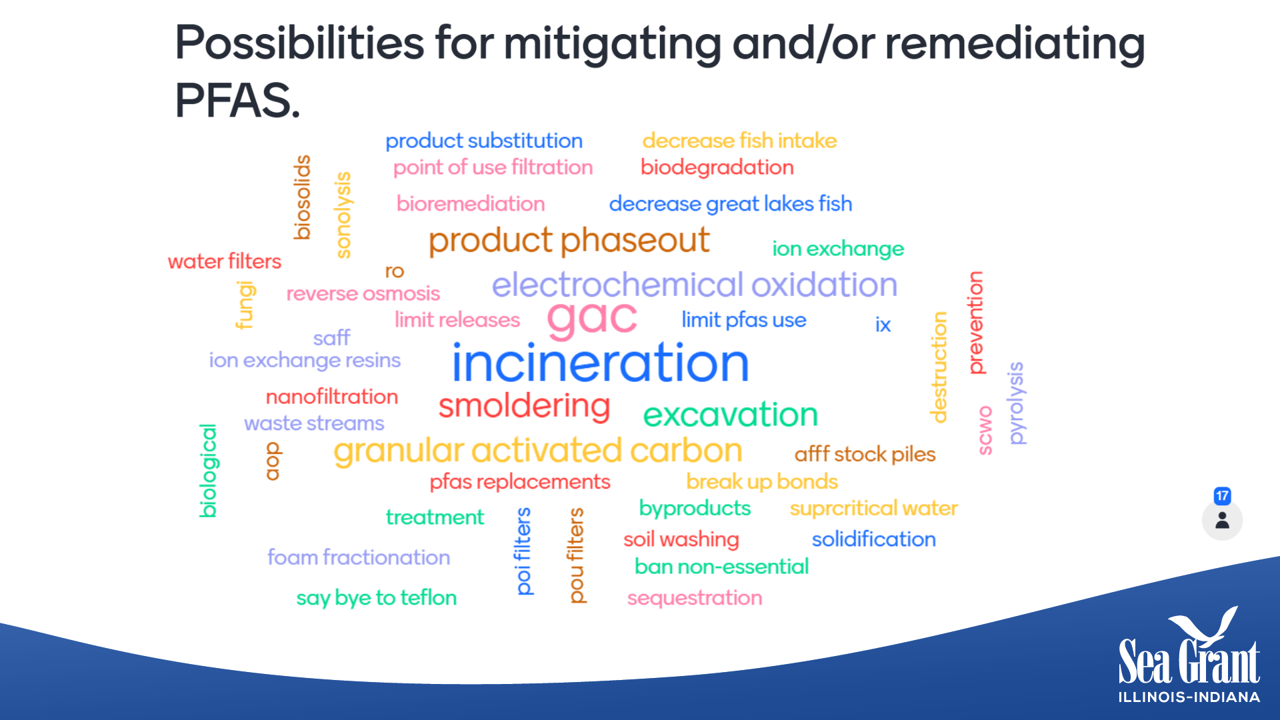
A word cloud generated during an exercise in the second PFAS scoping session.
Illinois-Indiana Sea Grant is a partnership between NOAA, University of Illinois Extension, and Purdue University Forestry and Natural Resources, bringing science together with communities for solutions that work. Sea Grant is a network of 34 science, education and outreach programs located in every coastal and Great Lakes state, Lake Champlain, Puerto Rico and Guam.
Contact: Carolyn Foley, Sarah Zack
December 19th, 2019 by Irene Miles
As 2019 draws to a close, I’m pleased to report that here at Illinois-Indiana Sea Grant, we’ve had a very good year, and that remained the case through the latter months.
In October, IISG underwent its program site review, which takes place every four years. Through this process, we presented our work from our last omnibus as well as our current activities to the external site review team. The review provides a great opportunity to reflect on our accomplishments and to look forward to new efforts.
The review team was very positive in its response, which, in large part, is due to not only the hard work of the IISG team, but also the great amount of support from our diverse partners, many of whom directly participated in the review.
This fall, we expanded our communication tools and products to share information about the Great Lakes with wider audiences. Inspired by a rich collection of photographs taken by Peter Essick, who works with National Geographic, IISG led the development of a photo essay called Great Lakes Resurgence about Areas of Concern in the region. The Great Lakes Sea Grant Network collaborated to tell the stories of these degraded waterways, to describe the progress of cleanup efforts and report local impacts of coastal restoration.
IISG now has a monthly podcast series, Teach Me about the Great Lakes, which debuted in December. Hosted by Stuart Carlton, the program’s assistant director, the podcast helps Stuart—and listeners—learn about the biology, ecology and natural history of the Great Lakes. Stuart is a social scientist who grew up in the south, so he is fairly new to Great Lakes issues. The first installment dove into concerns about microplastics, which have been found in the Great Lakes and many waterways all over the world. The next episode, available in early January, will focus on the geological history of the Great Lakes.
Autumn also brought awards season for the Sea Grant program, both regionally and nationally. We are proud of Pollution Prevention Specialist Sarah Zack, who was honored with the Great Lakes Sea Grant Network Early Career Award at the regional meeting in Sault St. Marie, Michigan. Irene Miles, strategic communication coordinator, won the Communications Service Award at the Sea Grant Extension Assembly, Communicator and Research Coordinator Conference in Savannah, Georgia. Also at the Savannah meeting, Brian Miller, IISG’s former director, was selected for the William Q. Wick Visionary Career Leadership Award, one of Sea Grant’s most prestigious honors.
As we all look forward to 2020, we wish you the best in the new year. For IISG, 2020 will bring an even greater focus to Lake Michigan. Scientists from around the Great Lakes basin will converge on the lake to conduct intensive research through the Cooperative Science and Monitoring Initiative (CSMI). IISG has just released an ESRI story map, Lake Michigan Health: A Deeper Dive, to share the results from the 2015 CSMI field year on Lake Michigan.
The Shipboard Science Workshop will also take place on Lake Michigan in the coming year. During this week-long workshop on the EPA research vessel the Lake Guardian, organized through the Center for Great Lakes Literacy, teachers from the region work side by side with scientists to study one of the Great Lakes. This coming year they set sail on Lake Michigan. We look forward to new science and stories that will emerge from both of these exciting initiatives.
Tomas Höök
Director, Illinois-Indiana Sea Grant
Illinois-Indiana Sea Grant is a part of University of Illinois Extension and Purdue Extension.
September 25th, 2019 by Irene Miles
Six Great Lakes Sea Grant programs have been awarded $1 million to work together on a three-year project to increase aquaculture production and sales in the region.
The Great Lakes Aquaculture Collaborative is one of 42 research projects and collaborative programs totaling $16 million aimed at advancing sustainable aquaculture in the United States funded by the National Sea Grant Office. The awards are dependent on the availability of federal funds.
Despite the fact that the Great Lakes comprise one of world’s largest freshwater ecosystems, aquaculture production in the region is failing to keep pace with increases in consumer demand for fish and seafood. This contributes to a national seafood trade deficit of $14 billion, second only to oil in the ranking of natural resource trade deficits.
“Through the Great Lakes Aquaculture Collaborative, our goal is to lay the foundation for an environmentally responsible, competitive and sustainable aquaculture industry,” said Stuart Carlton, IISG assistant director. “And from the consumer perspective, to provide more opportunities to buy locally raised protein in the form of farm-raised fish.”
Minnesota Sea Grant will lead the collaborative, and for its part, Illinois-Indiana Sea Grant (IISG) will explore perceived barriers to successful aquaculture operations in the Great Lakes region. Amy Shambach, IISG aquaculture marketing outreach associate, will interview producers, food distributors, grocers, restauranteurs and other key players to provide insights that inform efforts to improve aquaculture production and marketing.
“It is vital to the growth of the aquaculture industry in the Great Lakes region to not only assess the industry’s needs but to then get that information into the hands of farmers,” said Shambach.
The Great Lakes Aquaculture Collaborative is funded by National Sea Grant’s Advanced Aquaculture Collaborative Program. This program seeks to build the capacity of Sea Grant and its partners to advance aquaculture in areas where a foundation of knowledge and activity currently exists but where significant barriers to sustainable domestic marine and Great Lakes aquaculture remain.
“These investments are critical to advancing United States aquaculture in sustainable, thoughtful ways using the best science and talent across the country,” said National Sea Grant Director Jonathan Pennock. “With our 2019 investments, we can address critical gaps in information, understanding and connectivity of science to industry.”
IISG was also awarded a second grant to study challenges to raising walleye in aquaculture production. “Walleye has a local identity—it has a strong association with the Midwest, is available in restaurants as a commercially caught species, and may be suitable for aquaculture,” said Kwamena Quagrainie, IISG aquaculture marketing specialist.
Currently farm-raised walleye in Illinois and Indiana is minimal. Quagrainie, along with Carlton and Purdue University researchers Robert Rode and Joseph Balagtas, are leading a working group that aims to understand the business and real-world production barriers to raising these fish in an economically sustainable manner. National Sea Grant awarded them $96,000 to find answers.
“There is reason to believe that walleye aquaculture could be a boon in the two states, but a lot of background work needs to be done to see if it is even feasible,” added Quagrainie.
Illinois-Indiana Sea Grant is a part of University of Illinois Extension and Purdue Extension.
August 29th, 2018 by IISG
Evolution is often viewed through the lens of thousands of years. But it may have taken humans only a century or so to force evolutionary changes to fish in the Great Lakes, according to a Purdue University report.
Environmental factors over long periods of time often lead to beneficial traits in animals. But Tomas Höök, a professor in the Department of Forestry & Natural Resources at Purdue University and director of Illinois-Indiana Sea Grant, and colleagues believe there is evidence of fisheries-induced evolution (FIE) in the Great Lakes.
“Fishing and harvesting creates strong pressure that could select for certain genetic material in a fish population and lead to rapid human-induced evolution of the population,” Höök said.
A review, published in the Journal of Great Lakes Research, presents the case for rapid evolution, including case studies of two important fishery species — yellow perch and lake whitefish.
For yellow perch, Lake Michigan commercial fishing operations in the early 1990s overharvested perch, in particular large female fish. This led to an abundance of male fish as well as smaller females, since they were the most likely to have an opportunity to reproduce.
After a collapse of yellow perch populations, commercial fishing for the species was shut down and recreational angling for the species was restricted. Research shows that yellow perch quickly started to sexually mature later and at larger sizes once they weren’t susceptible to harvest.
“Importantly, this research suggests that FIE can occur rapidly, but that changes are reversible,” wrote the authors, which included Erin Dunlop from the Ontario Ministry of Natural Resources and Forestry, as well as Zachary Feiner and Höök from Purdue.
Lake whitefish populations have been affected by overfishing and invasive species in Lake Michigan and Lake Huron. Models suggest that high harvest rates and harvesting before whitefish reach sexual maturation could lead to rapid declines in population and the size at which fish mature.
Höök said fisheries-induced evolution has been widely studied in marine systems, but more needs to be done on freshwater species since many can be important ecologically and commercially.
“We need to assess the potential for fisheries-induced evolution in these systems to better understand the extent to which fishery managers can and should think about FIE when making key management decisions affecting fish populations,” Höök said.
July 18th, 2017 by Sea Grant
When a 180-foot ship marked with the words “U.S. ENVIRONMENTAL PROTECTION AGENCY” docks on the shores of one of the Great Lakes or their connecting channels, people take notice. The research vessel Lake Guardian has incited curiosity for over 25 years as it has carried scientists across all five Great Lakes to collect and analyze samples of water, aquatic life, sediments, and air.
Last year, IISG completed a project to answer frequently asked questions about the ship and to communicate the important work done on board to monitor and protect the world’s largest surface freshwater system.
Allison Neubauer, Joel Davenport, and Kristin TePas received an APEX Award of Excellence for the colorful display they created about the R/V Lake Guardian. Easily transported and exhibited from one port to the next, the display is made up of two large posters that use graphics and accessible language to communicate key facts about the ship, such as its size and berthing capacity, and provide a glimpse into the scientific sampling processes and Great Lakes research topics that the vessel facilitates.
Since making its debut last spring the display has proven to be a hit with people drawn to the ship. In particular, the eye-catching infographics designed by Davenport have been the subject of praise.
October 17th, 2016 by IISG
The National Sea Grant Program is celebrating its 50th anniversary this year and Illinois-Indiana Sea Grant (IISG) is looking back at its own origins through the eyes of its first leader.
In 1982, IISG had its modest beginnings as a small marine extension project, through a partnership of the University of Illinois, Purdue University, and the National Oceanic and Atmospheric Administration.
Robert Espeseth was at the helm from 1982 through 1994. Now a retired University of Illinois professor of leisure studies, he recalled those early years as both part happenstance and part destiny.
Like a star football quarterback recalling his glory days, he shared the play-by-play of the creation of IISG.
“Jim Peterson, who had a joint appointment with Purdue and Indiana, and I were up there at a Great Lakes regional workshop for recreation specialists in 1980,” Espeseth recalled. “And one of the fellows from Michigan was getting funding out of Michigan Sea Grant, and he said, ‘Have you guys ever looked into that?’ And we said, ‘What is it?’ And he said, ‘With Illinois and Indiana not being in the program they’re anxious to complete the Great Lakes for programs covering all the shoreline.’”
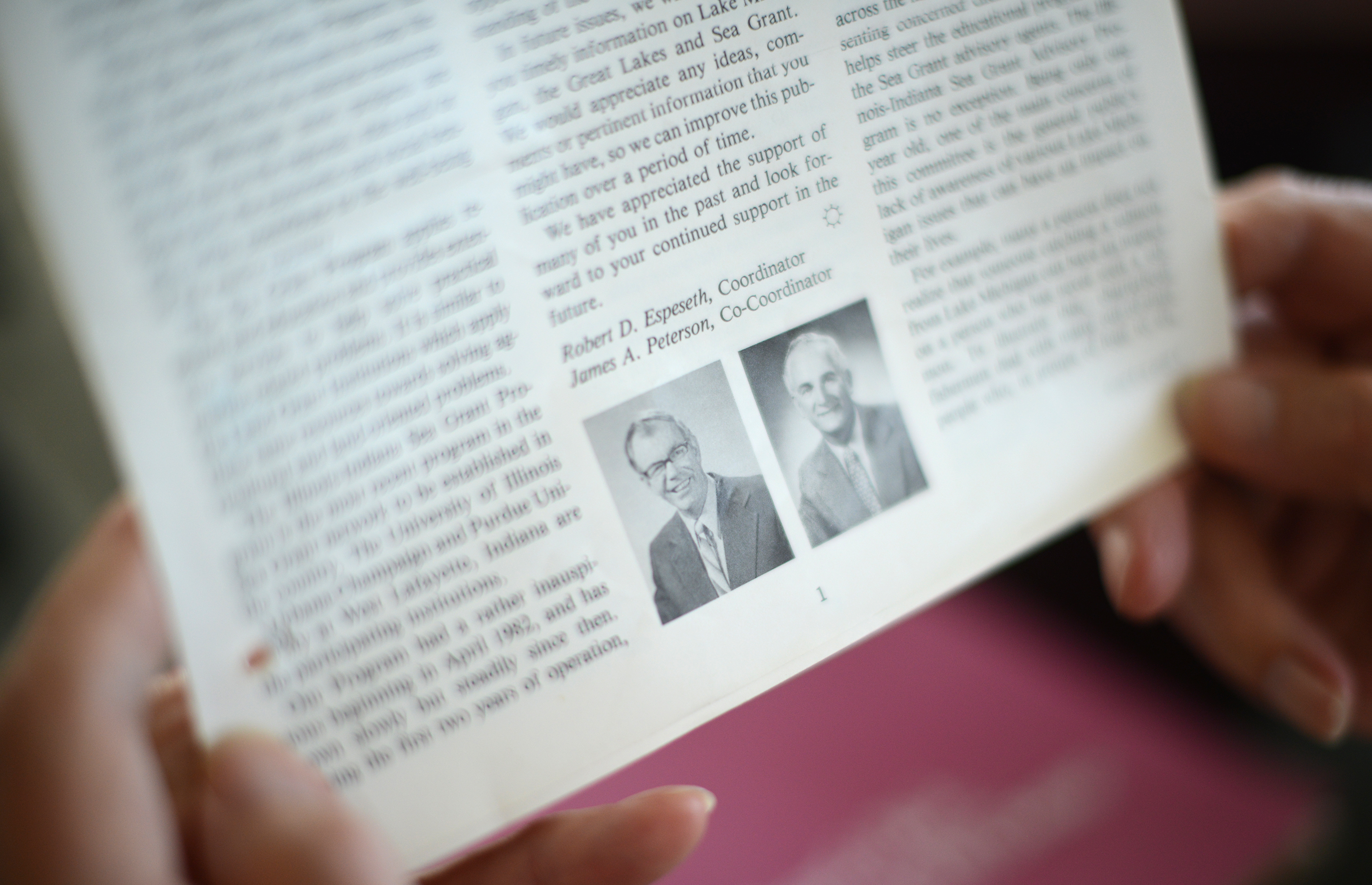
And with that exchange, the pursuit to “cover the shoreline” began.
Peterson and Espeseth were both going to be in Washington, so they decided to pay a visit the National Sea Grant Office in Silver Spring, Maryland.
They arrived without an appointment, but Espeseth wasn’t going to leave without meeting the director, and he had the perfect in.
It just so happened that the National Sea Grant Program director, the late Ned Ostenso, was a coxswain in the boat Espeseth rowed during his days at the University of Wisconsin.
“’He’s really busy, he wouldn’t have time,’” Espeseth recalled being told.
“I said, ‘Just call him and tell him Bob Espeseth is here.’ So he did and Ned said, ‘Bring him on up!’”
Ostesno encouraged Espeseth and Peterson and explained how anxious he was to get Illinois and Indiana onboard, but he warned that it would be a long process.
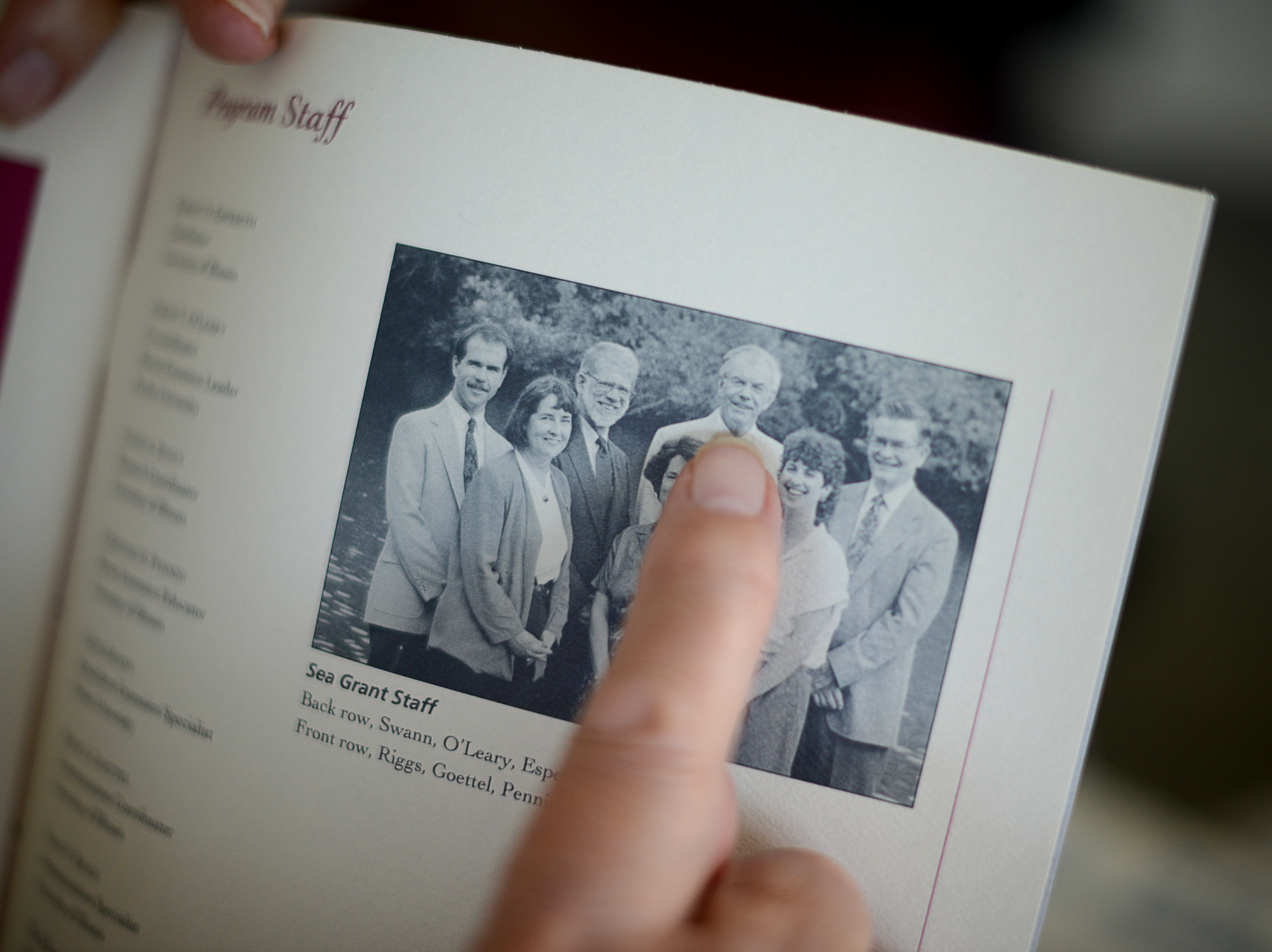
How right he was.
Their first application in 1981 was turned down for not having a strong research component and because the two universities, Purdue and Illinois, weren’t very supportive of the Sea Grant mission. It wasn’t until 1982 that IISG finally got approved as a marine extension project.
Yet, there was still some uncertainty about the focus and direction of the program.
Initially the emphasis was on aquaculture, recreation and shoreline tourism—topics that were not as popular with other Sea Grants. IISG really took off once it added more research-focused areas like invasive species, water quality and pollutants.
The outreach staff grew from a single specialist to a team of over 20, located at universities and agencies in the two states. In 1997, IISG was awarded College Program status by the U.S. Department of Commerce.
Espeseth smiled as he thought back to those early days.
“I just talked to Jim Peterson the other day and he said laughing, ‘Yeah, that was really a shot in the dark!’ But at the behest of our compatriot up there in Michigan, that’s how it got started.”
November 9th, 2015 by iisg_superadmin
While this year’s strong El Niño may play havoc in other parts of the country and the world, in the Great Lakes region it’s likely that we won’t need to talk about the polar vortex and the “snowpocalypse” this winter.
The Climate Prediction Center at NOAA is forecasting an increased chance of above-normal temperatures and a greater chance for below-normal precipitation across most of the Great Lakes region this winter.
“This does not mean that cold weather will not happen this winter,” said Molly Woloszyn, IISG climate specialist. “But typical extreme cold weather may be milder and less frequent.”
An El Niño develops when sea surface temperatures are warmer than average in the equatorial Pacific for an extended period of time. This year’s version is already considered to be strong and likely to become a bit stronger. Although each El Niño is different, they offer some predictable patterns.
 Unlike the past two winters when heavy snow and bitter cold were the norm, if warmer conditions do occur this winter, this may mean less ice cover on the lakes. It might also mean reduced snowpack accumulation and therefore, less runoff into the lakes, which is a major contributor to lake levels.
Unlike the past two winters when heavy snow and bitter cold were the norm, if warmer conditions do occur this winter, this may mean less ice cover on the lakes. It might also mean reduced snowpack accumulation and therefore, less runoff into the lakes, which is a major contributor to lake levels.
Also, less lake ice means more evaporation off the lake surfaces. “Since the lakes are mostly at above average levels right now, this could lead to a return to normal water levels,” said Woloszyn.
Mild winters can have many positives impacts in the region. They are typically good for the economy (unless you are in the snow business)—heating costs go down, transportation runs smoother, and retail sales pick up. And they are generally good for agriculture, although some crop pests are more likely to survive the winter.
July 9th, 2015 by iisg_superadmin
Fifteen educators from six states surrounding the Great Lakes are getting the chance to be scientists in the field – or rather water – during this year’s Shipboard Science Workshop in Lake Michigan on the Lake Guardian, the U.S. EPA Great Lakes National Program Office (GLNPO) research vessel. The annual workshop will take place the week of July 12-18 and is hosted by Illinois-Indiana Sea Grant (IISG).
The teachers, alongside four research scientists from U.S. EPA GLNPO, University of Wisconsin-Milwaukee and Loyola University Chicago, will take part in sampling to evaluate the presence of microplastics and assess the impact of aquatic invasive species, especially zebra and quagga mussels.
And as part of the workshop, teachers will be able to analyze the samples in on-board laboratories. The hope is that the teachers will take their experiences back to the classroom and inspire their own students to want to do scientific exploration of the Great Lakes.
This workshop is IISG community outreach specialist Kristin TePas’ fifth, and she never tires of seeing teachers learning and researching in the field.
“Aside from the concept of educators working side by side with scientists collecting and analyzing data, these cruises have a lot of variation from year to year because the scientists change and thus the focus of research taking place is often different,” TePas said.
“I always look forward to watching how the educators take to the whole experience. They come on rather green and leave at the end of the week looking like they have always lived on the ship and working like a well-oiled machine with the field sampling and then analyzing in the lab.”
Bonnie Sansenbaugher, a teacher from last year’s workshop on Lake Erie, made sure she took advantage of the experience and didn’t return to her classroom empty-handed.
“As we were covering the curriculum portion of the workshop I was making notes of which lessons I will use for which class and which month I will cover that topic,” she wrote on the Center for Great Lakes Literacy blog.
On July 12, the ship will set sail from Milwaukee, with stops in Manitowoc, WI on the 14th, and Frankfort, MI on the 16th. This year, four educators from Illinois and two from Indiana will be making the trip.
Teachers will be tweeting and blogging on this cruise as well. Look for them on twitter at #lakeguardian and on the Teacher Features page on the CGLL website.
Each year a different lake within the world’s largest freshwater system goes under the microscope for this kind of intensive look-see. Next year it’s Lake Superior’s turn.
This workshop is funded through the Great Lakes Restoration Initiative. Wisconsin Sea Grant was a key partner in planning this year’s event.
-Abigail Bobrow








